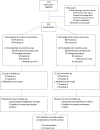A Parent Coach Model for Well-Child Care Among Low-Income Children: A Randomized Controlled Trial
- PMID: 26908675
- PMCID: PMC4771128
- DOI: 10.1542/peds.2015-3013
A Parent Coach Model for Well-Child Care Among Low-Income Children: A Randomized Controlled Trial
Abstract
Objective: The goal of this study was to examine the effects of a new model for well-child care (WCC), the Parent-focused Redesign for Encounters, Newborns to Toddlers (PARENT), on WCC quality and health care utilization among low-income families.
Methods: PARENT includes 4 elements designed by using a stakeholder-engaged process: (1) a parent coach (ie, health educator) to provide anticipatory guidance, psychosocial screening and referral, and developmental/behavioral guidance and screening at each well-visit; (2) a Web-based tool for previsit screening; (3) an automated text message service to provide periodic, age-specific health messages to families; and (4) a brief, problem-focused encounter with the pediatric clinician. The Promoting Healthy Development Survey-PLUS was used to assess receipt of recommended WCC services at 12 months' postenrollment. Intervention effects were examined by using bivariate analyses.
Results: A total of 251 parents with a child aged ≤12 months were randomized to receive either the control (usual WCC) or the intervention (PARENT); 90% completed the 12-month assessment. Mean child age at enrollment was 4.5 months; 64% had an annual household income less than $20,000. Baseline characteristics for the intervention and control groups were similar. Intervention parents scored higher on all preventive care measures (anticipatory guidance, health information, psychosocial assessment, developmental screening, and parental developmental/behavioral concerns addressed) and experiences of care measures (family-centeredness, helpfulness, and overall rating of care). Fifty-two percent fewer intervention children had ≥2 emergency department visits over the 12-month period. There were no significant differences in WCC or sick visits/urgent care utilization.
Conclusions: A parent coach-led model for WCC may improve the receipt of comprehensive WCC for low-income families, and it may potentially lead to cost savings by reducing emergency department utilization.
Trial registration: ClinicalTrials.gov NCT02262962.
Copyright © 2016 by the American Academy of Pediatrics.
Conflict of interest statement
Figures
References
-
- Hagan JF, Shaw JS, Duncan PM, eds. Bright Futures: Guidelines for Health Supervision of Infants, Children and Adolescents. 3rd ed. Elk Grove Village, IL: American Academy of Pediatrics; 2008
-
- Simon GR, Baker C, Barden GA III, et al. ; Committee on Practice and Ambulatory Medicine; Bright Futures Periodicity Schedule Workgroup . 2014 Recommendations for pediatric preventive health care. Pediatrics. 2014;133(3):568–570 - PubMed
-
- Donabedian A. The quality of care. How can it be assessed? JAMA. 1988;260(12):1743–1748 - PubMed
-
- Donabedian A. Evaluating the quality of medical care. Milbank Mem Fund Q 1966;44(3):suppl:166–206 - PubMed
-
- Starfield B. Health services research: a working model. N Engl J Med. 1973;289(3):132–136 - PubMed


